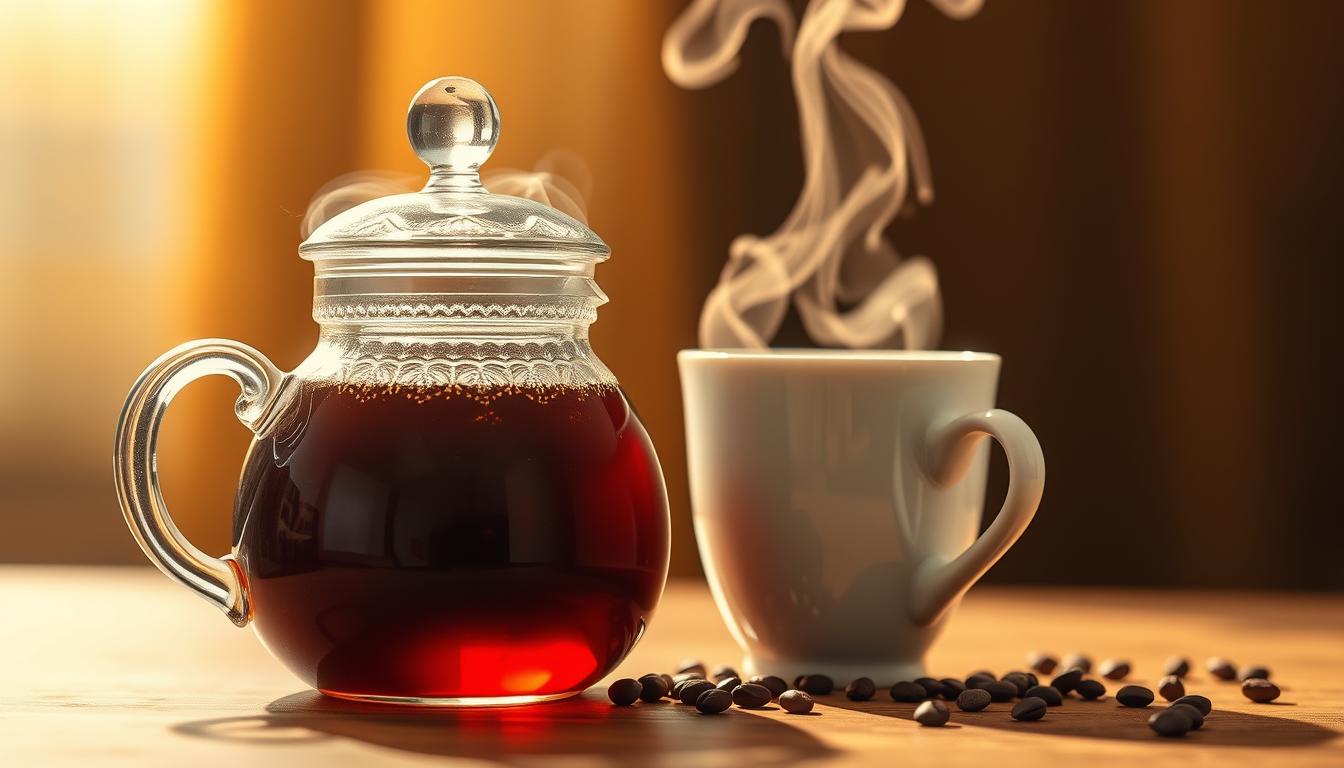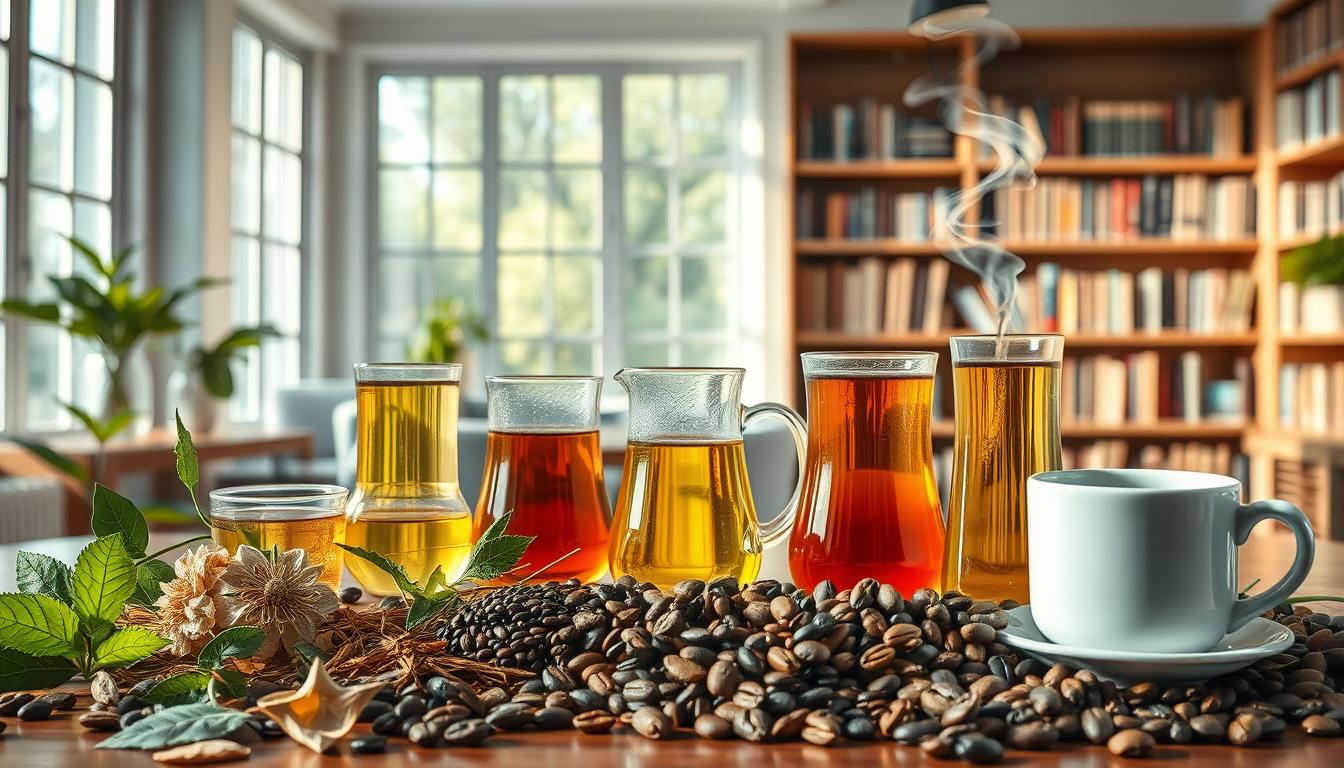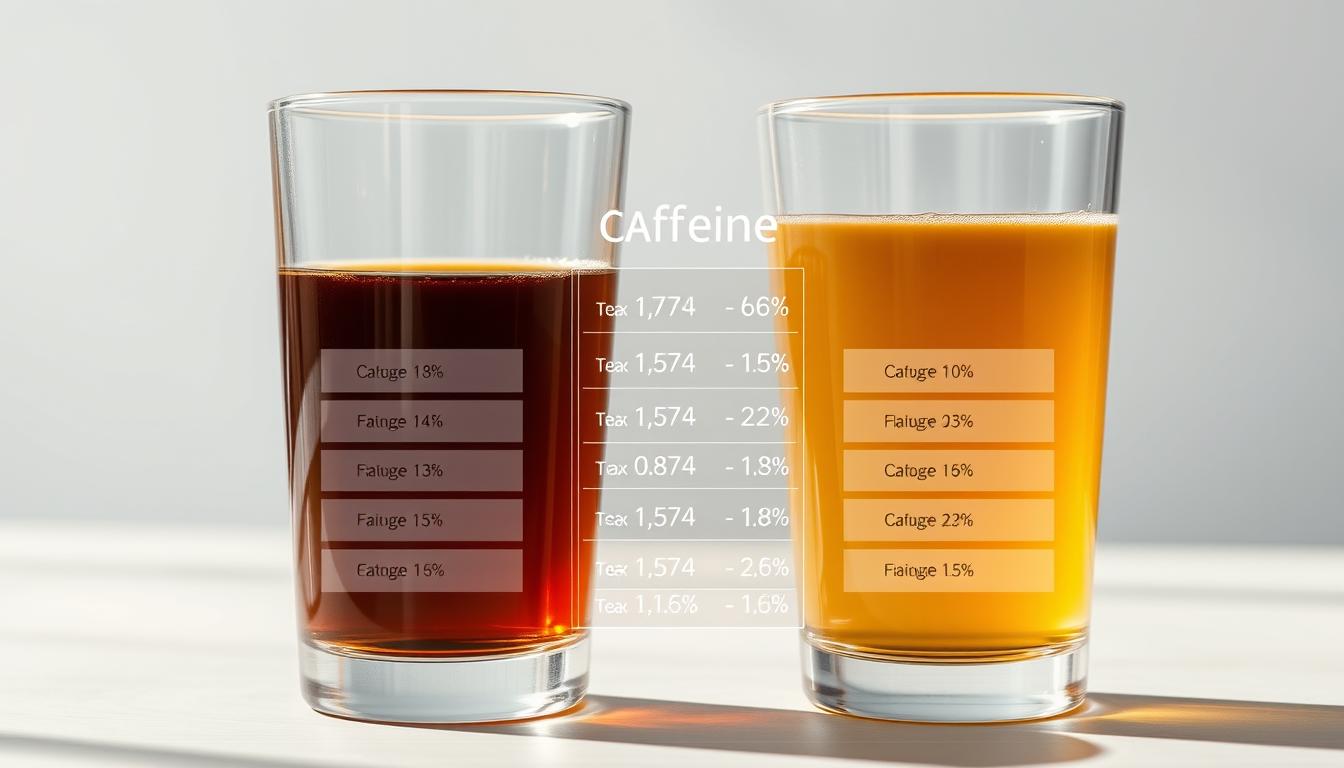Did you know that tea leaves naturally contain a higher percentage of caffeine than coffee beans? Yet, when brewed, a cup of coffee typically packs a stronger punch. This surprising fact raises the question: how does the caffeine content in your favorite beverages compare?
The answer lies in the brewing process. Factors like water temperature, steeping time, and the type of tea or coffee used play a significant role. For instance, black tea and espresso have distinct caffeine levels due to their preparation methods.
This article dives into the details, exploring how different tea varieties and coffee styles affect your daily caffeine intake. Whether you’re a green tea enthusiast or a brewed coffee lover, understanding these differences can help you make informed choices.
Key Takeaways
- Tea leaves naturally contain more caffeine per milligram than coffee beans.
- Brewing methods significantly impact the caffeine content in your cup.
- Water temperature and steeping time are key factors in caffeine extraction.
- Different tea varieties, like black and green, have varying caffeine levels.
- Understanding caffeine content helps you choose the right beverage for your needs.
Understanding Caffeine: From Plant to Cup
Caffeine is a fascinating compound found in many plants, including tea and coffee. This bitter alkaloid is naturally present in over 60 plant species, acting as a protective agent for leaves and buds. It’s not just a stimulant for humans; it’s a natural pesticide that helps plants thrive.

What is Caffeine?
Caffeine is a naturally occurring alkaloid that belongs to a group of compounds called methylxanthines. It’s found in varying concentrations in the leaves of the tea plant (Camellia sinensis) and the seeds of the coffee plant. While tea leaves may contain more caffeine per milligram, the brewing process determines how much ends up in your cup.
The Role of Caffeine in Tea and Coffee
In plants, caffeine serves as a natural defense mechanism. It deters pests and protects young leaves and buds. For humans, it’s a stimulant that boosts alertness and cognitive function. Studies show that caffeine can improve focus and energy levels, but excessive intake may lead to side effects like restlessness or insomnia.
The way caffeine is extracted during brewing plays a crucial role in its final content. Hot water and steeping time influence how much caffeine is released into your beverage. Whether you prefer a cup of green tea or brewed coffee, understanding this process helps you tailor your drink to your needs.
Factors Impacting Caffeine Content in Your Beverage
The caffeine in your cup depends on several key factors. From the type of plant to the brewing process, each step plays a role in determining the final amount. Understanding these elements can help you tailor your drink to your preferences.

Leaves, Beans, and Brewing Methods
Tea leaves naturally contain about 3.5% caffeine, while coffee beans have a lower percentage. However, the way these ingredients are used makes a difference. For example, a cup of brewed coffee typically uses more beans, resulting in higher caffeine levels.
Brewing factors like water temperature and steeping time also matter. Hotter water and longer steeping extract more caffeine. This is why a strong black tea can have more caffeine than a lightly brewed green variety.
Processing Techniques and Oxidation Levels
Processing methods significantly impact caffeine content. Black tea undergoes full oxidation, which enhances its caffeine levels. In contrast, green tea is minimally processed, retaining less caffeine.
For instance, Tazo Earl Grey, a black tea, contains more caffeine than Stash Green Tea. Even slight changes in brewing, like using hotter water, can lead to noticeable differences in your beverage.
does tea have more caffeine than coffee: A Detailed Comparison
When it comes to caffeine, not all beverages are created equal. The amount in your cup depends on the type of plant, brewing method, and serving size. Let’s break down the differences between tea and coffee to help you make the best choice for your needs.
Comparing Tea Varieties: Black, Green, and White
Different tea types offer varying levels of caffeine. Black tea, like Twinings English Breakfast, averages 47-90 mg per cup. It’s fully oxidized, which enhances its caffeine content. Green tea, such as Stash Premium, contains 20-45 mg. Its minimal processing retains less caffeine. White tea varies widely, often falling between 10-60 mg per cup. Its delicate leaves and shorter steeping time result in lower caffeine levels.
Exploring Coffee Types: Brewed, Espresso, and More
In contrast, coffee often packs a stronger punch. An 8-ounce cup of brewed coffee contains 95-170 mg of caffeine. Espresso, a concentrated shot, delivers 63 mg per ounce. Starbucks’ Pike Place Roast, for example, offers 310 mg in a 16-ounce serving. Cold brew, steeped for hours, can reach 200 mg per cup. The brewing process and serving size play a significant role in these numbers.
While tea leaves naturally contain more caffeine per milligram, the way coffee is brewed extracts higher amounts. Whether you prefer a calming cup of green tea or a robust espresso, understanding these differences helps you tailor your drink to your preferences.
Health Effects and Safe Caffeine Intake
Caffeine plays a dual role in our lives, offering both benefits and risks depending on how much we consume. Understanding its effects can help you make informed choices about your daily beverage intake.
Benefits and Potential Risks of Caffeine
Moderate consumption of caffeine can provide several advantages. It enhances alertness, improves mood, and even boosts metabolism. Many people rely on their morning cup to kickstart their day.
However, excessive intake can lead to negative outcomes. Symptoms like anxiety, restlessness, and sleep disturbances are common. It’s essential to find the right balance to enjoy the benefits without the drawbacks.
Recommended Caffeine Limits for Daily Consumption
Health organizations, including the USDA and EFSA, recommend a daily limit of up to 400 mg of caffeine for healthy adults. This amount is roughly equivalent to four cups of brewed coffee or ten cups of black tea.
Here’s a quick breakdown of how different drinks contribute to your daily total:
- Brewed coffee (8 oz): 95-170 mg
- Espresso (1 oz): 63 mg
- Black tea (8 oz): 47-90 mg
- Green tea (8 oz): 20-45 mg
By monitoring your intake, you can enjoy your favorite drink while staying within safe limits. Remember, everyone’s tolerance varies, so listen to your body and adjust accordingly.
Optimizing Your Brew: Tips for the Best Cup
Brewing the perfect cup involves more than just pouring hot water over leaves or grounds. The right techniques can enhance flavor while managing caffeine levels. Whether you’re a tea enthusiast or a coffee lover, these tips will help you craft a beverage tailored to your preferences.
Mastering Water Temperature and Steeping Time
Water temperature plays a crucial role in flavor and caffeine extraction. For tea, use water between 160°F and 185°F for green or white varieties. Black tea requires hotter water, around 200°F. Steeping time also matters. A shorter steep (1-2 minutes) yields a milder flavor, while longer steeping (3-5 minutes) extracts more caffeine but can result in bitterness.
For coffee, water just off the boil (195°F to 205°F) is ideal. Brewing time varies by method. A French press takes 4 minutes, while an espresso shot requires only 25-30 seconds. Experiment to find your perfect balance.
Choosing the Right Ratio and Equipment
The ratio of water to leaves or grounds is key. For tea, use one teaspoon of leaves per 8 ounces of water. Coffee requires one to two tablespoons per 6 ounces. Using the right equipment, like a gooseneck kettle for precise pouring or a French press for full immersion, can elevate your brew.
| Beverage | Water Temperature | Steeping/Brewing Time | Recommended Ratio |
|---|---|---|---|
| Green Tea | 160°F – 185°F | 1-3 minutes | 1 tsp per 8 oz |
| Black Tea | 200°F | 3-5 minutes | 1 tsp per 8 oz |
| Brewed Coffee | 195°F – 205°F | 4 minutes | 1-2 tbsp per 6 oz |
| Espresso | 195°F – 205°F | 25-30 seconds | 1-2 tbsp per shot |
By adjusting these factors, you can create a drink that suits your taste and caffeine needs. Remember, brewing is both an art and a science—experiment to find what works best for you.
Conclusion
Understanding the nuances of your favorite drinks can transform your daily routine. Whether you prefer a calming tea or a robust coffee, the caffeine content varies based on brewing methods and types. Black and green teas offer gentler stimulation, while brewed coffee delivers a stronger kick.
Health experts recommend staying within safe limits—up to 400 mg of caffeine daily. This ensures you enjoy the benefits, like improved focus, without the risks of overconsumption. Adjusting water temperature and steeping time can also optimize flavor and potency.
Experiment with different brewing techniques to find what suits your taste and energy needs. Share your discoveries with others and explore new ways to enjoy your daily drink. Remember, moderation and personalization are key to the perfect cup.

